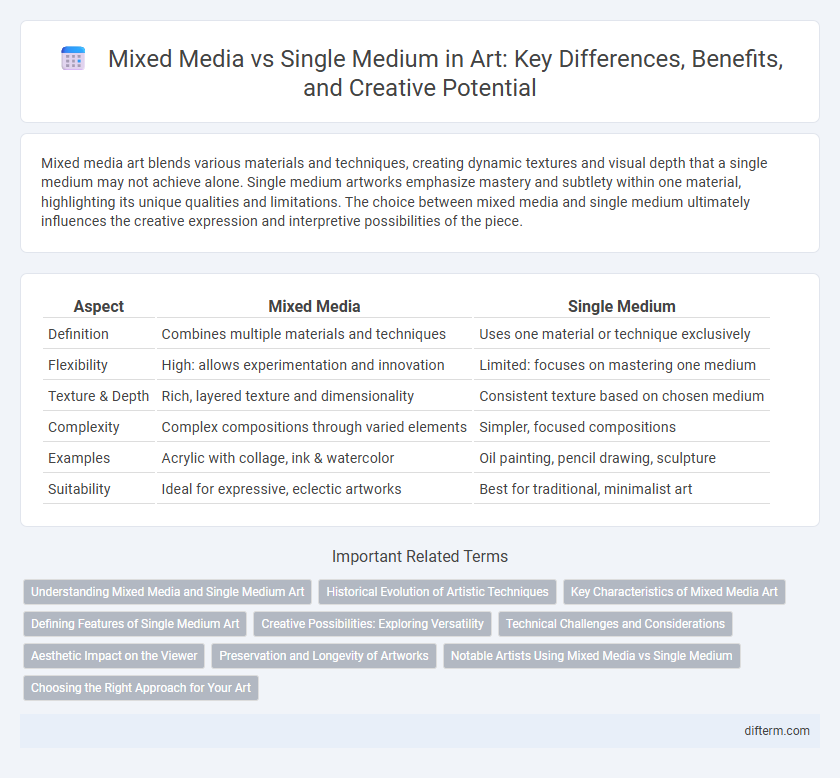Mixed media art blends various materials and techniques, creating dynamic textures and visual depth that a single medium may not achieve alone. Single medium artworks emphasize mastery and subtlety within one material, highlighting its unique qualities and limitations. The choice between mixed media and single medium ultimately influences the creative expression and interpretive possibilities of the piece.
Table of Comparison
| Aspect | Mixed Media | Single Medium |
|---|---|---|
| Definition | Combines multiple materials and techniques | Uses one material or technique exclusively |
| Flexibility | High: allows experimentation and innovation | Limited: focuses on mastering one medium |
| Texture & Depth | Rich, layered texture and dimensionality | Consistent texture based on chosen medium |
| Complexity | Complex compositions through varied elements | Simpler, focused compositions |
| Examples | Acrylic with collage, ink & watercolor | Oil painting, pencil drawing, sculpture |
| Suitability | Ideal for expressive, eclectic artworks | Best for traditional, minimalist art |
Understanding Mixed Media and Single Medium Art
Mixed media art combines various artistic materials and techniques, such as paint, collage, and ink, to create intricate, textured compositions that enhance visual depth and originality. Single medium art focuses on mastering one material, like oil paint or graphite, allowing artists to explore and refine specific techniques and styles to achieve precision and cohesiveness. Understanding the distinctions between mixed media and single medium art enriches artistic expression and informs choices in creative processes and exhibition presentation.
Historical Evolution of Artistic Techniques
Mixed media art has evolved significantly since its early 20th-century emergence, combining diverse materials like paint, paper, and fabric to break traditional boundaries. Pioneers such as Pablo Picasso and Georges Braque integrated collage elements into Cubist works, challenging the limitations of single medium techniques that dominated earlier art history. This historical evolution reflects a shift from exclusive use of oil or watercolor to more experimental, layered compositions, enriching artistic expression and expanding the visual vocabulary.
Key Characteristics of Mixed Media Art
Mixed media art combines various materials such as paint, fabric, paper, and found objects to create layered textures and depth unmatched by single medium works. This approach fosters experimentation and contrasts, enabling artists to explore diverse techniques and visual effects within one piece. The fusion of different materials often results in dynamic, tactile surfaces that invite viewers to engage more closely with the artwork's multi-dimensional qualities.
Defining Features of Single Medium Art
Single medium art centers on the use of one material or technique, such as oil paint, charcoal, or clay, emphasizing mastery and depth within a specific medium. This approach highlights the intrinsic qualities, texture, and properties of the chosen material, allowing artists to explore its full potential and limitations. The clarity and consistency in single medium works often result in a cohesive aesthetic and focused artistic expression.
Creative Possibilities: Exploring Versatility
Mixed media art expands creative possibilities by combining diverse materials such as paint, fabric, and found objects, allowing artists to explore texture, depth, and dimension beyond the limitations of a single medium. Single medium art, like oil painting or charcoal drawing, emphasizes mastery and depth within one specific material, fostering refined techniques and focused expression. The versatility of mixed media supports innovation and unexpected results, while single medium work cultivates precision and dedicated skill development.
Technical Challenges and Considerations
Mixed media art presents technical challenges related to material compatibility, such as differing drying times and surface textures, which can affect adhesion and longevity. Artists must carefully consider the archival qualities of each medium to prevent degradation or discoloration over time. In contrast, single medium works offer consistency in application and maintenance but may limit textural and visual complexity compared to the layered possibilities of mixed media.
Aesthetic Impact on the Viewer
Mixed media artworks combine diverse materials and techniques, creating layered textures and complex visuals that engage viewers more deeply compared to single medium pieces. The interplay of different elements in mixed media often produces unexpected contrasts and dynamic compositions, enhancing the aesthetic impact and emotional resonance. Single medium art, while potentially more focused, offers clarity and coherence but may lack the multidimensional appeal that mixed media provides.
Preservation and Longevity of Artworks
Mixed media artworks often face greater challenges in preservation and longevity due to the varied materials interacting differently over time, which can lead to uneven degradation. Single medium pieces generally benefit from standardized conservation methods tailored to the specific material, ensuring more predictable aging and restoration outcomes. Understanding the chemical and physical properties of each medium is crucial for effective preservation strategies that extend the life of both mixed media and single medium artworks.
Notable Artists Using Mixed Media vs Single Medium
Notable artists like Robert Rauschenberg and Anselm Kiefer are celebrated for their innovative use of mixed media, combining painting, sculpture, and found objects to create multidimensional works. In contrast, single medium artists such as Vincent van Gogh and Georgia O'Keeffe are recognized for their mastery and iconic contributions within specific mediums like oil painting. The versatility of mixed media offers dynamic textural possibilities, while single medium artists emphasize depth and technique within one artistic form.
Choosing the Right Approach for Your Art
Selecting the right approach between mixed media and a single medium depends on the desired texture, depth, and expression in your artwork. Mixed media offers versatility by combining various materials like paint, collage, and ink to create complex, layered pieces, while single medium provides a focused exploration of techniques within one material such as oil, watercolor, or graphite. Artists should consider their creative goals, technical skills, and the message they wish to convey to determine which method enhances their artistic vision most effectively.
Mixed media vs single medium Infographic

 difterm.com
difterm.com